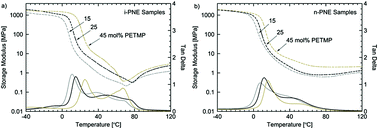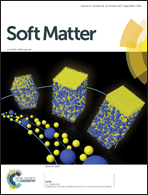Liquid-crystal order during synthesis affects main-chain liquid-crystal elastomer behavior
Abstract
This study presents the first direct comparison of the influence of liquid-crystal order during synthesis on the thermo-mechanical behaviors of main-chain liquid-crystal elastomers (LCEs) in thiol–acrylate networks. Six polydomain nematic elastomer (PNE) chemistries were compared directly by synthesizing with the mesogens in either an isotropic state (i-PNE) or a nematic state (n-PNE). The i-PNE networks were created in the presence of solvent, which disrupted any liquid-crystal order during network formation. Conversely, the n-PNE networks were created without the presence of solvent below the isotropic transition (TNI). Differential scanning calorimetry (DSC) was first performed, and it showed that i-PNE networks experienced a clearly defined nematic-to-isotropic transition upon heating, whereas the transition in n-PNE networks was unable to be identified, which may be the result of a nematic-to-paranematic phase transition. Dynamic mechanical analysis (DMA) tests revealed that while both networks maintained elevated loss tangent in the nematic region, only i-PNE networks prominently displayed dynamic soft elasticity behavior. The two-way shape switching behaviors of LCE networks were examined using actuation tests under a 100 kPa bias stress. It showed that the strain amplitude strongly depends on synthesis history; it ranges from 66% to 126% in i-PNE samples and 3% to 61% in n-PNE samples. To help interpret the different actuation strain behaviors between i-PNEs and n-PNEs, wide-angle X-ray scattering (WAXS) was then performed where the LCE samples were strained to 40%. The results showed that order parameter (S) in n-PNE samples (ranging from 0.37 to 0.50) is lower than that in i-PNE samples (0.54 for all cases), and the parameter decreased as the cross-linking density increased. The stress–strain behaviors of the LCE networks measured from uniaxial tension tests revealed that all i-PNE samples had a lower soft-elasticity plateau during loading compared to the n-PNE samples. Finally, free-standing strain recovery of LCE samples after being strained to 100% was investigated. Immediately after removing stress on the samples, i-PNE and n-PNE samples recovered 14% to 38% and 27% to 73% of strain, respectively. We discuss the advantages and disadvantages of the different synthetic histories on LCE design.

- This article is part of the themed collection: Liquid Crystal Elastomers


 Please wait while we load your content...
Please wait while we load your content...